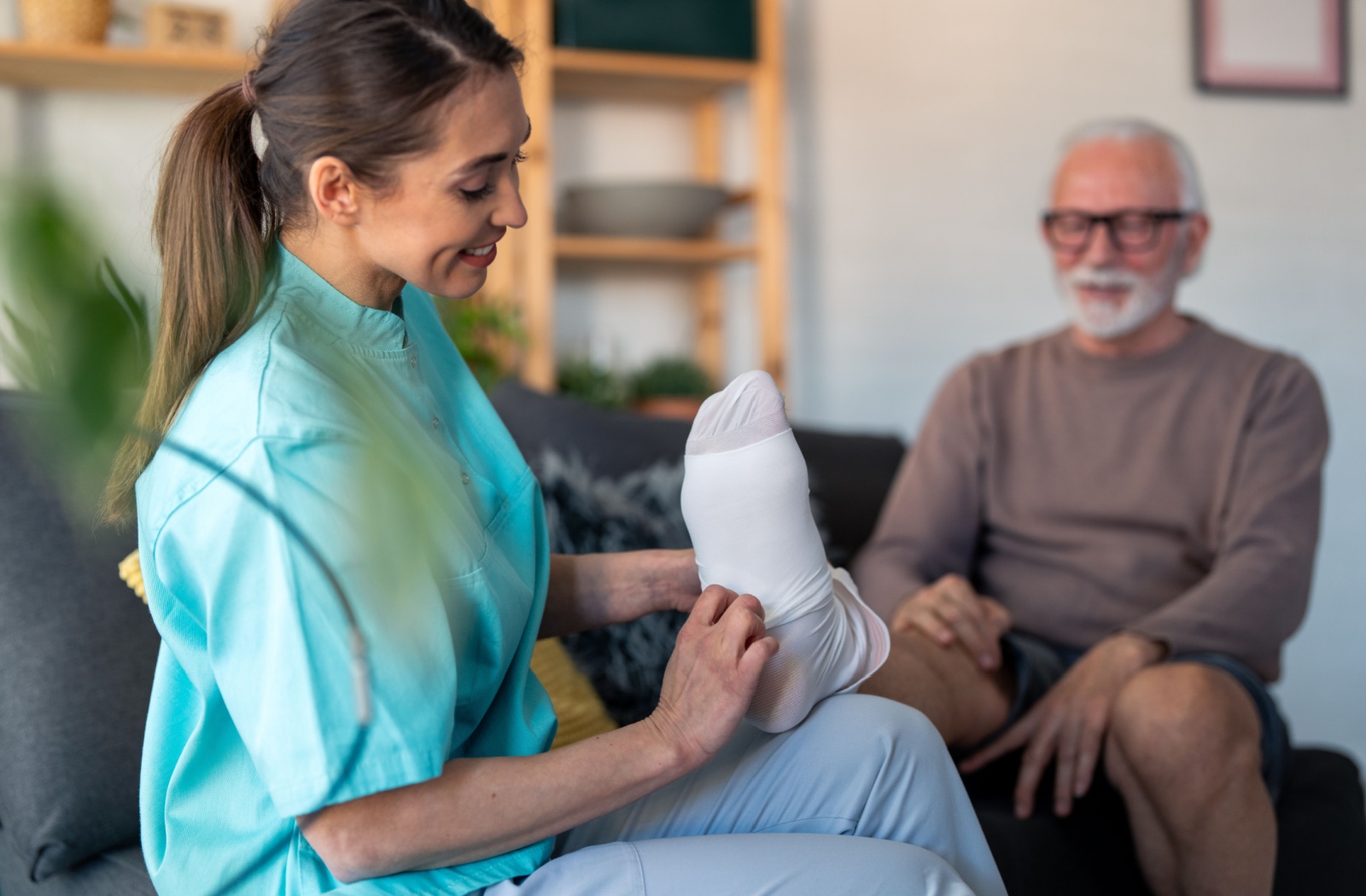Key Takeaways
- Compression socks can provide relief for certain types of knee pain by improving circulation and reducing swelling
- They work through graduated pressure that promotes blood flow and supports muscles around the knee
- Proper sizing and compression levels are important for safety and effectiveness
- They’re most helpful for pain related to poor circulation, swelling, or minor joint instability
- Compression socks should be part of a comprehensive approach to knee pain management
Compression Socks and Knee Pain
Knee pain can significantly impact your daily activities and overall comfort. Whether you’re dealing with occasional discomfort or ongoing issues, you’ve likely explored options to restore your quality of life. Fortunately, it’s sometimes easier than you think. You deserve a higher quality of life, and something as simple as compression socks could help.
Compression socks can help with certain types of knee pain. They’re especially helpful when the discomfort stems from poor circulation, swelling, or the need for additional joint support during activities. While they’re not a cure-all solution, many people find them to be a helpful part of their pain management approach.
Knee Pain & Its Impact on Daily Activities
Knee discomfort is a common concern for many older adults. It’s not just discomfort, either. Knee pain interferes with daily routines and leads to significant problems with independence.
Types of Knee Pain: Acute vs. Chronic
Acute knee pain often develops quickly after a strain or minor injury. It usually improves within days or weeks when given proper rest and attention.
On the other hand, chronic knee pain tends to linger for months or longer. It often stems from conditions such as arthritis, where stiffness and swelling fluctuate throughout the day and may worsen with activity or weather changes.
Common Causes of Knee Pain in Adults
Arthritis remains one of the leading sources of knee discomfort. It develops when cartilage gradually wears down and movement becomes more difficult. However, it’s not the only condition known to cause knee pain.
Other frequent causes include:
- Past injuries that haven’t fully healed
- Muscle weakness around the knee joint
- Circulation issues in the legs
- Excess weight adding pressure to the joints
Each of these affects you a little differently, but all lead to frustration and discomfort.
How Knee Pain Affects Your Independence
Persistent knee pain can make once-simple activities—like walking, gardening, or climbing stairs—more challenging. Over time, this can limit movement and your ability to participate in favorite pastimes. When mobility becomes limited, it’s natural to feel frustrated or concerned about maintaining your independence.
How Compression Socks Work for Knee Pain
Compression socks use gentle, graduated pressure to support circulation and relieve tension in the legs. For those managing knee discomfort, these small adjustments can make a noticeable difference in daily mobility.
Compression socks can:
- Improve circulation in the legs
- Reduce swelling and stiffness
- Add light support around the knee
- Ease muscle fatigue
- Support recovery after activity
- Increase comfort while sitting or standing
Worn regularly, compression socks can help keep legs feeling lighter, steadier, and more comfortable throughout the day.
Choosing the Right Compression Socks for Your Needs
Finding the right compression socks makes a big difference in both comfort and effectiveness. A few key details—like compression level, fit, and length—help determine what works best for your routine and activity level.
Compression Levels and mmHg Ratings
Compression strength is measured in millimeters of mercury (mmHg). For everyday support, a mild level (around 15–20 mmHg) is generally comfortable for most adults. It’s often helpful to begin with lighter compression to see how your legs respond before moving up.
Proper Sizing and Fit for Maximum Comfort
A proper fit matters as much as the compression level itself. Measure your leg in the morning at the ankle, calf, and knee, when swelling is at its lowest. Well-fitting socks should be snug but not tight, and should stay smooth against your skin without bunching up. If you notice indents in your skin after removing the socks, they’re too tight.
Full-Length vs. Knee-High Options
Knee-high compression socks usually provide enough support for mild knee discomfort and are easier to put on and remove. They extend from your foot to just below your knee and provide support to the entire lower leg.
Full-length options may be recommended if you also experience thigh pain or have circulation concerns that extend above the knee. However, these can be more challenging to put on independently.
How Long Should You Wear Compression Socks on Your Knee?
Many people wear compression socks during active hours—typically from morning until evening—or during activities that involve extended standing or walking. Start with shorter periods to let your body adjust. If the socks feel uncomfortable, consider a lower compression level or recheck the sizing.

Other Ways to Support Your Knee Health
Maintaining knee health involves more than rest and recovery. It’s about balance, movement, and proper nourishment. Along with compression socks, lifestyle adjustments help strengthen the body and support your lasting comfort.
Nutrients That Support Joint Strength
Nutrition plays an important role in joint comfort and flexibility. Vitamin D supports calcium absorption and bone strength, while nutrients like vitamin B12 and magnesium contribute to muscle and nerve health. A balanced diet with fruits, vegetables, and lean proteins helps the body maintain strong, resilient joints over time.
Gentle Movement and Activity
Regular, low-impact activity helps maintain flexibility and circulation around the knees. Simple routines like walking on even ground, swimming, or light stretching can keep muscles active without adding strain. Listening to your body’s signals and pacing yourself allows for consistency while avoiding discomfort.
Avoiding Prolonged Inactivity
Staying still for too long can weaken the muscles that support your knees. Gentle daily movement helps preserve strength and stability, which may ease discomfort and improve balance. Even short walks or light exercises can make movement feel easier over time.
Taking the Next Steps Toward Preserving Your Independence
Managing knee pain effectively often involves trying different approaches to see what works for you. Compression socks may be one tool in your toolkit, but they don’t address the underlying issue. A well-rounded plan is the key to making comfort and mobility part of your daily life. That’s why our team at Somerby Mobile is dedicated to helping residents stay active, supported, and connected every day.
Remember that you don’t have to navigate these challenges alone. Whether you’re exploring compression socks or other pain management strategies, we’re here to support you every day. It’s what you deserve, and we’re ready to help. Schedule a tour with us today to learn how!









